(1)
Narayana Hridayalaya Multispeciality, Bangalore, India
Head and neck cancer is a major health challenge in developing world. The habit of tobacco chewing and smoking is quite prevalent in this part of the world, making head neck cancer as one of most common cancers. Many people live in socioeconomically compromised situation and they present at a very advanced stage of the disease (50–60 % of all patients). This makes their treatment complicated and costly. The treatment facilities are diverse in large developing countries and many patients are treated in centers with basic infrastructure. It is difficult to maintain consistency in treatment delivery, and many patients receive compromised care.
It is essential to understand the infrastructure available in a center where one is working. This helps in deciding treatment approaches that are feasible in that setup. It is advisable to form a guideline that is feasible in the center and deliver consistent treatment [1]. It is possible to perform most complicated and challenging surgery with basic setup if the surgeon is well trained and experienced enough to work in that environment [1–3].
The operative room setup is similar to any other general surgery and otolaryngology surgery theater. One needs to have a cautery machine, drill and saw system with plating kit, and suction machine as basic requirements. The anesthetist should have experience in managing difficult airway or one has to perform tracheostomy in majority of cases for induction. We also prefer to perform elective tracheostomy in postoperative period as intensive care unit (ICU) facilities are very basic in most part. It is also feasible to perform microvascular free flap reconstruction in such setup if microscope is available [3]. It is also possible to do anastomosis with loops, and this can increase feasibility of this procedure in remote location.
The aim of this chapter is to demonstrate that almost any complicated procedure is possible with proper planning. We prefer to use regional flaps for reconstruction as far as possible as this is safer, less intensive, quick, and cost-effective. Patients recover earlier and postoperative care is easy. The extent of resection remains the same, and this helps in maintaining oncological outcome at par with other centers. There has been a conscious effort all throughout this book to demonstrate reconstruction with regional flaps to highlight that all the surgical concepts described in this book are feasible in all setup. Many cases of advanced cancers treated with compartment surgery concept that are demonstrated in this book were performed in a rural clinic. This chapter contains few challenging clinical situation that were solved in a simple manner with available resources.
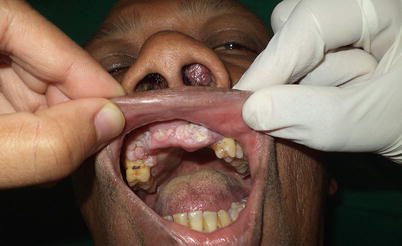
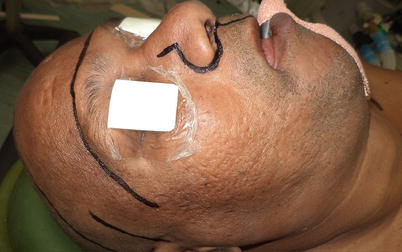
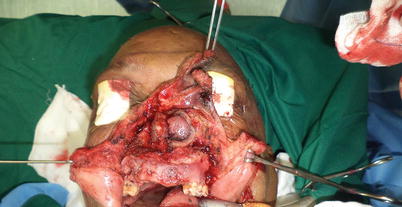
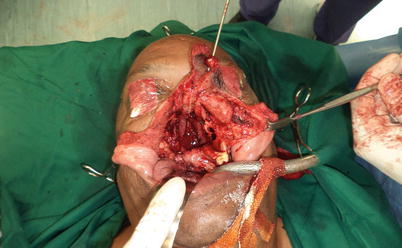
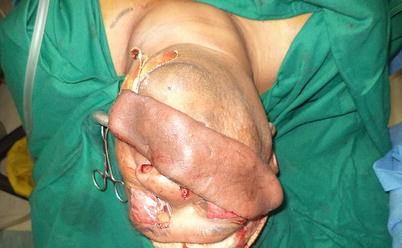
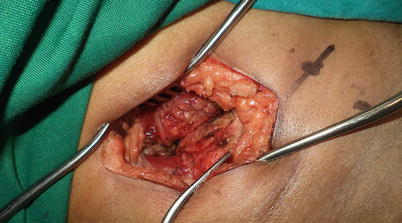
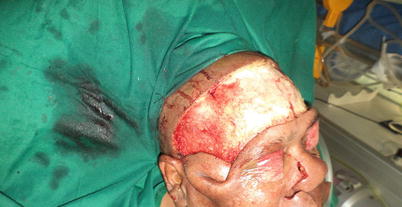
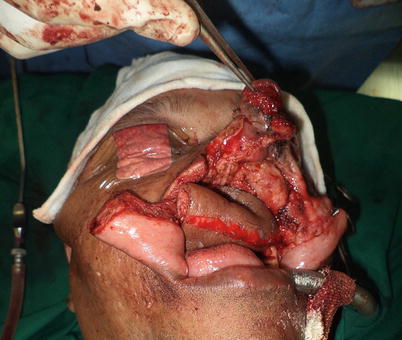





Fig. 15.1
A patient with cancer involving central arch maxilla with extension onto hard palate and bilateral maxillary sinus. The reconstruction is the major challenge and ideally requires vascularized bone flap. This patient had many comorbidities and it was not possible to perform such reconstruction in a limited setup by a single surgeon

Fig. 15.2
A lateral rhinotomy incision with planned forehead flap

Fig. 15.3
Photograph showing adequate exposure for resection

Fig. 15.4
The resection is complete

Fig. 15.5
The forehead flap is raised

Fig. 15.6
The iliac crest bone graft is harvested

Fig. 15.7
The flap is tunneled below the skin

Fig. 15.8
The flap is sutured to palate and de-epithelized for lip portion
< div class='tao-gold-member'>
Only gold members can continue reading. Log In or Register to continue
Stay updated, free articles. Join our Telegram channel

Full access? Get Clinical Tree


